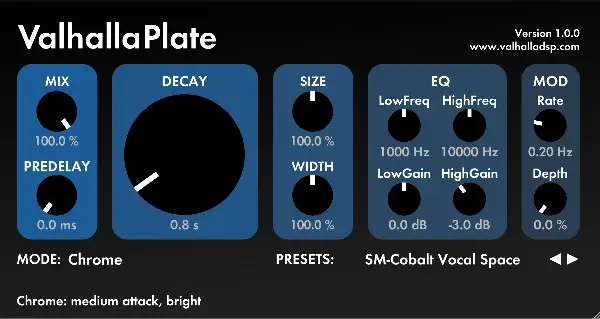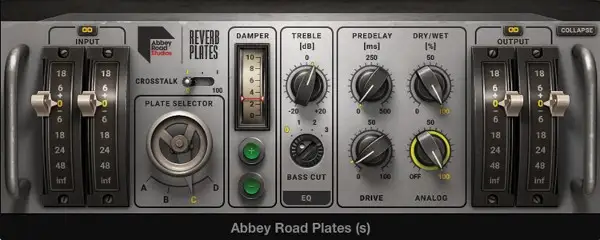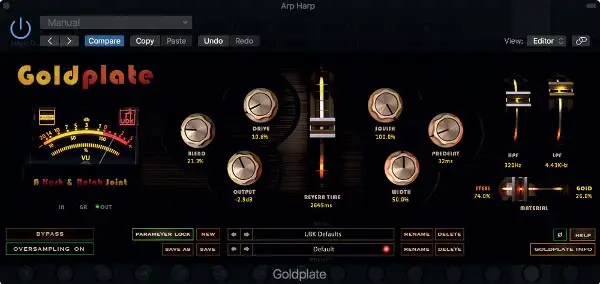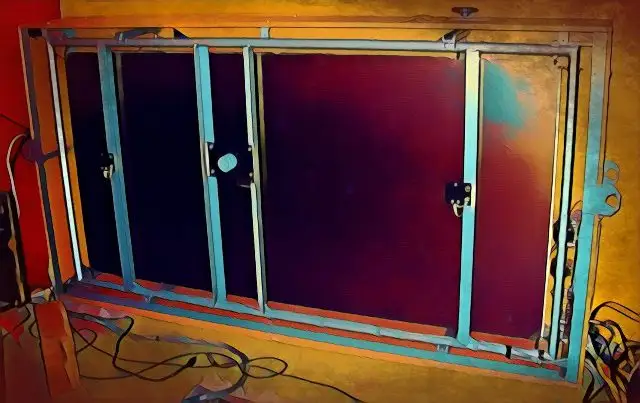Plate reverb was one of the earliest pieces of studio technology that enabled the addition of artificial ambiance to recorded music. This one-of-a-kind innovation revolutionized the mixing process, introducing new and stylish reverb techniques for music of all kinds.
While the significance of plate reverb is undoubtedly widely acknowledged, many new engineers have no idea what it is and what makes it distinctive. If there's anything that I believe makes someone a better producer and engineer, it's understanding things at their foundation.
Plus, if you are new to music production, you may be curious about the importance of this particular type of reverb.
In this guide, I'm going to give you an overview of plate reverb, talk about some of its unique characteristics, and recommend a few plugins for all budgets!
What Is Plate Reverb?
Plate reverb is an artificial reverberation technique that is used to change and improve the spatial characteristics of a recording. Before plugins, the original effect was achieved by transmitting a dry signal through a large sheet of metal and then capturing the output with a microphone.
Plate reverb is distinct for having a dense and velvety sound, which was extensively employed for vocal tracks during the 1960s and 1970s. Even to this day, it is the reverb of choice for pop vocals.
However, due to the substantial size and weight of the metal plate used, these units were primarily found in top-of-the-line professional studios.
The thing that makes plate reverb units so unique is that they operate by utilizing transducers to transform the audio signal into vibrations. These vibrations then stimulate the metal plate.
Another set of transducers on the opposite side of the plate converts these vibrations back into an audio signal that can be mixed in parallel with the dry recording.
This process generates a thick and harmonically-rich reverb effect that imitates the early reflections of your typical room.
Upon its initial development, plate reverb technology represented a significant advancement in the generation of realistic reverb effects, far surpassing the spatial possibilities prior.
Even today, the distinctive sound of plate reverb remains highly coveted. To satisfy the demand for this unique sound, software developers have designed plugins that replicate the effect's signature density and decay.
Plate Reverb - Best Uses
Smooth Vocals
One of my favorite uses for plate reverb is on vocals, and I'm certainly not alone in that preference.
I particularly appreciate it on lead vocals, especially when I want to achieve a distinctive sound that sets the vocal track apart from the rest of the instrumental.
In cases where other elements in the mix are more "realistic" in terms of the space around them, employing plate reverb on the lead vocal can provide it with a unique spotlight.
Plate reverb is also one of my favorite reverb choices for backing vocals. Again, it's helpful for distinguishing them from the mix, though equally as helpful when aiming for a distant sound. However, to achieve the intended background effect, it's important to low-pass your reverb with an EQ to get rid of some of the high-frequency content.
PRO TIP - I often utilize plate reverb on its own bus, where all the vocals in a track are sent, in differing amounts, depending on how "far away" you want each of them to sit.
Of course, it's important to note that plate reverb may not be suitable for every vocal track, and there are times when it can sound too produced or vintage.
As with anything you ever do in a mix, allow your ears to guide you.
Velvety String Sections
No matter the emotional quality of your strings, the sparkling quality of plate reverb can complement them near seamlessly.
If you've ever tracked a live string ensemble, then you might know that it's common to place the mics at a significant distance from the players to give them a considerable amount of natural ambiance.
Leaving these string tracks without any added reverb can give you a stark sound, which can be particularly effective, depending on the context of your track.
However, when you want long, expensive reverb tails for your string section, plate reverb is ideal. Because plate reverbs generate a unique reverb sound that differs from the natural reverb found in an acoustic space, you can emphasize both the natural room sound captured during the string recording and the artificial reverb without either of them feeling out of context.
Majestic Drums
If you're looking for a drum reverb with epic, extended tails, plate reverb can be an ideal choice.
Of course, it may not be the crushed room verb you're used to on Bonham's drums or the gated reverbs used on just about every 80s track, though plate reverb offers a classic sound akin to vintage drum sounds. Even when a drum track features room microphones or other natural ambient elements, plate reverb can provide added depth along with a slight bit of vintage sophistication.
If you have ample space in your mix for long reverb tails to stand out, you might even consider sending each piece of your drum kit to a separate bus with a plate reverb plugin on it.
However, if the rest of the arrangement is more intricate, you can send a few drums, such as the close mics on your toms or snare.
My Top 5 Favorite Plate Reverb Plugins
1. UAD EMT 140 Plate

One of the earliest plate reverb emulations I familiarized myself with is this incredibly accurate replica of the legendary EMT 140 by UAD . It closely resembles, functions, and produces the same sound as the original hardware plate reverbs.
While I also have a couple of other plate plugins that I frequently use, I still find myself selecting this one quite often.
2. Valhalla Plate

Sean Costello, the developer over at Valhalla, has concentrated his reverb product range on exceptional ambiance effects, using out-of-this-world scientific techniques for replication. Better yet, all Valhalla digital reverbs are incredibly affordable.
The Valhalla Plate plugin offers several algorithms that simulate various plate materials, ranging from typical selections such as brass and steel to more unconventional choices like lithium.
3. Waves Abbey Road Plates

Abbey Road Studios is one of the most renowned institutions in the music industry. During the analog recording's golden age, they pioneered several innovations that contributed to the modern recording workflow.
Their selection of customized plate reverbs has gained widespread recognition over the years. Thanks to Waves Abbey Road Plates , you can experience the exclusive sound of the iconic studio's reverb, with three distinct plate types wrapped up in it.
4. Soundtoys - Little Plate

Sometimes less is more, and the makers of Soundtoys Little Plate embraced this principle in designing their plugin.
The controls are super minimal on this plugin, offering only a few settings for decay time, mix, and low cut. As the cherry on top, you get a single modulation switch, which you can toggle on and off for some added character.
It's a very user-friendly tool that allows you to quickly get that plate tone on your tracks.
5. Kush Audio Goldplate

One plate emulation I'm into right now is Goldplate by Kush . The thing that truly sets it apart from other digital reverbs is the incorporation of carefully selected additional features, including saturation, compression, and filtering, which you'll often find on Kush plugins. It's a solid, all-in-one package that fits perfectly with the signal chain I usually find myself setting up for plate reverbs anyway.
As Popular Today As It Ever Was
Plate reverb continues to be one of the most popular sounds, even with the advancements in artificial reverb technology. Many producers still prefer the unique qualities of the original hardware.
Make sure to check out some of the high-quality plugins above to recreate its authentic sound in your DAW!





